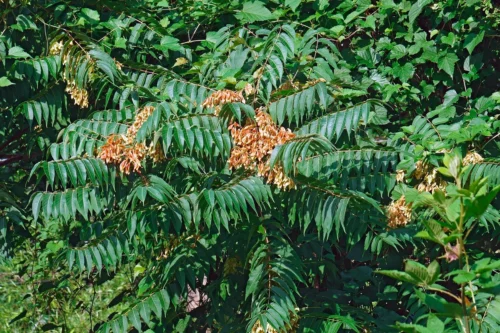
Mosquito Joe explains why Tree of Heaven is an invasive species that threatens native plants and attracts pests.
|
Have you considered adding flowers or other plants to your backyard? It’s a great way to spruce up the area and really embrace what the summer is all about. But before you begin, you should be aware of potential issues you might face, and we’re not talking about insects.
The tree of heaven is an invasive plant species that could already be growing in the soil around your home or near plants in your yard. Either way, if you come across this plant, it’s essential to let the qualified service professionals at Mosquito Joe® remove it from your property. Although we specialize in outdoor pest control services, we can also help with these trees.
How to Identify a Tree of Heaven

Tree of heaven identification can be tricky because it has a similar appearance to other species. It has pinnately compound leaves featuring a central stem with leaves on each side. But it stands out because the stem is a reddish-brown color. If you run your hand across the stem, you will also feel a little fuzz.
Another factor that can help you pin down the tree-of-heaven plant in your yard is the smell. Whenever you break a twig or crush one of the leaves, it’s followed by a foul odor. When this tree secures its roots and leaves start growing, a chemical is released into the soil that’s toxic to other plants. Plus, it reproduces rapidly, allowing it to infiltrate areas and knock out other species.
How to Remove a Tree of Heaven
If you suspect you might have a tree of heaven in your backyard, it would be best to dispose of it. Keeping it around will kill the remaining plant life as the roots spread. It will also create a habitat for the unwanted spotted lanternfly, an insect that can do extra damage.
Rather than dealing with these issues, get rid of the tree of heaven. A simple way to control its growth is by pulling seedlings by hand before the roots get a chance to develop. Once roots take hold, it’ll be much more challenging to remove them. Even if you do, removal might not be clean, and the root fragments can resprout.
Cutting a mature tree-of-heaven plant from the ground level may seem like the best course of action, but it’s not for two reasons:
- Cutting is a process that will have to continue for a few years to weaken the plant.
- When a tree of heaven gets cut, it produces root suckers which are hazardous to other plants in the area.
So, instead, attack the roots using herbicides. It’s an effective method for removing a tree of heaven that may be too comfortable.
Invasiveness of the Tree of Heaven
When you see trees and leaves, the idea that they might harm each other probably doesn’t occur to you. But as mentioned, the tree of heaven is an invasive plant species that does more harm than good.
While its roots make their way into the soil and get cozy, they destroy other roots and disperse a toxic chemical that hurts other plants. Furthermore, you’ll see more spotted lanternflies around because of them (their favorite type of grub). And they won’t be so friendly to the other plants and flowers you might have around.
Tree-of-heaven threats don’t stop there. Since these trees can thrive as long as there’s soil and space, you may find them peeking through cracks in concrete or building foundations. If left unattended for too long, they could cause lasting damage.
Difference Between Tree of Heaven vs. Sumac
Again, the tree of heaven has a lot of similarities to other species, which can make it challenging if you want to remove it from your yard. But there are a few ways to tell the difference between it and sumac trees. We already mentioned a few above, like the reddish-brown stem and the foul odor emanating from the leaves when crushed. However, there are a few other ways to differentiate between a tree of heaven and a sumac.
Tree of Heaven
- Grows in colonies
- Does not thrive in full sun
- Has smooth leaves with a longer trunk and can grow up to about 80 feet tall
Sumac
- Can produce berries or drupes when female
- Has branches that are covered in brown hairs
- Has leaves that are serrated at the base
- Has a short trunk that can grow up to 40 feet tall
Keep an eye out for these trees in your backyard and consider removing them with the help of the professionals at Mosquito Joe. We specialize in tree of heaven removal and other important services. Our commitment to excellence and the Neighborly Done Right Promise® ensure complete satisfaction. Request a free quote to find out more!
